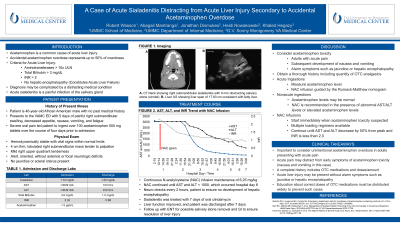Monday Poster Session
Category: Liver
P3094 - A Case of Acute Sialadenitis Distracting from Acute Liver Injury Secondary to Accidental Acetaminophen Overdose
Monday, October 28, 2024
10:30 AM - 4:00 PM ET
Location: Exhibit Hall E

Has Audio

Robert Wasson, BS
University of Mississippi Medical Center
Flowood, MS
Presenting Author(s)
Robert Wasson, BS1, Abagail Matranga, BS2, Jonathan Dismukes, MD, MBA3, Heidi Nowakowski, MD2, Khaled Hegazy, MD2
1University of Mississippi Medical Center, Flowood, MS; 2University of Mississippi Medical Center, Jackson, MS; 3University of Mississippi Medical Center, Brandon, MS
Introduction: Accidental overdose accounts for roughly half of acetaminophen overdoses in the US. This case portrays accidental acetaminophen toxicity in the setting of a distracting medical problem, sialadenitis.
Case Description/Methods: A 46-year-old male with no medical history presented after five days of painful right submandibular swelling with associated decreased appetite, fatigue, nausea, and vomiting. Due to severe oral pain, the patient ingested one hundred tablets of acetaminophen 500 mg during the four days leading to admission. Vital signs were stable on arrival. Physical exam revealed a 4 cm firm, lobulated right submandibular mass and mild abdominal right upper quadrant tenderness. Patient was alert, fully oriented, without asterixis, and without jaundice. Labs were significant for creatinine 1.72 mg/dL, AST >3039 IU/L, ALT >3039 IU/L, total bilirubin 3.8 mg/dL, INR 2.32, leukocytosis 12.6 X10^9/L, and lactate 4.1 mmol/L. Computed tomography of the neck revealed right submandibular sialadenitis with obstructing stone which was treated with seven days of oral clindamycin. Continuous N-acetylcysteine (NAC) infusion was started at 6.25 mg/kg for acute liver injury presumed secondary to acetaminophen toxicity. Acetaminophen level was < 5 μg/mL, but given the timing of ingestion, this was difficult to interpret. Acute hepatitis panel was negative. Liver US showed enlarged, fatty liver without fibrotic findings. The patient remained neurologically stable. Gastroenterology recommended continuing NAC infusion until AST and ALT were both less than 1000 IU/L which occurred on hospital day 6. The patient was discharged home with otolaryngology follow up for possible removal of salivary duct stone.
Discussion: Recommendations state that NAC infusion should start immediately once acetaminophen toxicity is identified. This is guided by the Rumack-Matthew nomogram for acute ingestions. For ingestions occurring over 24 hours from time of presentation, treatment with NAC is recommended in the presence of abnormal AST/ALT levels or elevated acetaminophen levels. Treatment is continued until AST and ALT decrease by 50% of peak values and INR is less than 2.0. Education about correct doses of over-the-counter medication must be distributed widely to prevent such cases. This case highlights the importance of investigating unintentional acetaminophen overdose in adults presenting with acute pain and development of nausea and vomiting even in the absence of alerting symptoms, like altered mental status or jaundice.
Disclosures:
Robert Wasson, BS1, Abagail Matranga, BS2, Jonathan Dismukes, MD, MBA3, Heidi Nowakowski, MD2, Khaled Hegazy, MD2. P3094 - A Case of Acute Sialadenitis Distracting from Acute Liver Injury Secondary to Accidental Acetaminophen Overdose, ACG 2024 Annual Scientific Meeting Abstracts. Philadelphia, PA: American College of Gastroenterology.
1University of Mississippi Medical Center, Flowood, MS; 2University of Mississippi Medical Center, Jackson, MS; 3University of Mississippi Medical Center, Brandon, MS
Introduction: Accidental overdose accounts for roughly half of acetaminophen overdoses in the US. This case portrays accidental acetaminophen toxicity in the setting of a distracting medical problem, sialadenitis.
Case Description/Methods: A 46-year-old male with no medical history presented after five days of painful right submandibular swelling with associated decreased appetite, fatigue, nausea, and vomiting. Due to severe oral pain, the patient ingested one hundred tablets of acetaminophen 500 mg during the four days leading to admission. Vital signs were stable on arrival. Physical exam revealed a 4 cm firm, lobulated right submandibular mass and mild abdominal right upper quadrant tenderness. Patient was alert, fully oriented, without asterixis, and without jaundice. Labs were significant for creatinine 1.72 mg/dL, AST >3039 IU/L, ALT >3039 IU/L, total bilirubin 3.8 mg/dL, INR 2.32, leukocytosis 12.6 X10^9/L, and lactate 4.1 mmol/L. Computed tomography of the neck revealed right submandibular sialadenitis with obstructing stone which was treated with seven days of oral clindamycin. Continuous N-acetylcysteine (NAC) infusion was started at 6.25 mg/kg for acute liver injury presumed secondary to acetaminophen toxicity. Acetaminophen level was < 5 μg/mL, but given the timing of ingestion, this was difficult to interpret. Acute hepatitis panel was negative. Liver US showed enlarged, fatty liver without fibrotic findings. The patient remained neurologically stable. Gastroenterology recommended continuing NAC infusion until AST and ALT were both less than 1000 IU/L which occurred on hospital day 6. The patient was discharged home with otolaryngology follow up for possible removal of salivary duct stone.
Discussion: Recommendations state that NAC infusion should start immediately once acetaminophen toxicity is identified. This is guided by the Rumack-Matthew nomogram for acute ingestions. For ingestions occurring over 24 hours from time of presentation, treatment with NAC is recommended in the presence of abnormal AST/ALT levels or elevated acetaminophen levels. Treatment is continued until AST and ALT decrease by 50% of peak values and INR is less than 2.0. Education about correct doses of over-the-counter medication must be distributed widely to prevent such cases. This case highlights the importance of investigating unintentional acetaminophen overdose in adults presenting with acute pain and development of nausea and vomiting even in the absence of alerting symptoms, like altered mental status or jaundice.
Disclosures:
Robert Wasson indicated no relevant financial relationships.
Abagail Matranga indicated no relevant financial relationships.
Jonathan Dismukes indicated no relevant financial relationships.
Heidi Nowakowski indicated no relevant financial relationships.
Khaled Hegazy indicated no relevant financial relationships.
Robert Wasson, BS1, Abagail Matranga, BS2, Jonathan Dismukes, MD, MBA3, Heidi Nowakowski, MD2, Khaled Hegazy, MD2. P3094 - A Case of Acute Sialadenitis Distracting from Acute Liver Injury Secondary to Accidental Acetaminophen Overdose, ACG 2024 Annual Scientific Meeting Abstracts. Philadelphia, PA: American College of Gastroenterology.
